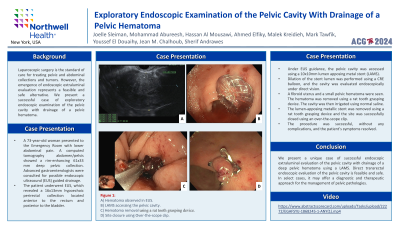Tuesday Poster Session
Category: Endoscopy Video Forum
P3883 - Exploratory Endoscopic Examination of the Pelvic Cavity With Drainage of a Pelvic Hematoma
Tuesday, October 29, 2024
10:30 AM - 4:00 PM ET
Location: Exhibit Hall E

Has Audio

Joelle Sleiman, MD
Staten Island University Hospital, Northwell Health
Staten Island, NY
Presenting Author(s)
Joelle Sleiman, MD, Mohammad Abureesh, MD, Hassan Al Moussawi, MD, Ahmed ` Elfiky, MD, Malek Kreidieh, MD, Mark Tawfik, DO, Youssef El Douaihy, MD, Jean M. Chalhoub, MD, Sherif Andrawes, MD
Staten Island University Hospital, Northwell Health, Staten Island, NY
Introduction: Laparoscopic surgery is the standard of care for treating pelvic and abdominal collections and tumors. However, the emergence of endoscopic extraluminal evaluation represents a feasible and safe alternative. We present a successful case of exploratory endoscopic examination of the pelvic cavity with drainage of a pelvic hematoma.
Case Description/Methods: A 73-year-old woman presented to the Emergency Room with lower abdominal pain. A computed tomography abdomen/pelvis showed a rim-enhancing 61x33 mm deep pelvic collection. Advanced gastroenterologists were consulted for possible endoscopic ultrasound (EUS) guided drainage. The patient underwent EUS, which revealed a 16x13mm hypoechoic perirectal collection located anterior to the rectum and posterior to the bladder. General surgery consultation was obtained during the procedure, and they were available on site. Under EUS guidance, the pelvic cavity was accessed using 10x10mm lumen apposing metal stent (LAMS). Dilation of the stent lumen was performed using a CRE balloon, and the cavity was evaluated endoscopically under direct vision. A fibroid uterus and a small pelvic hematoma were seen. The hematoma was removed using a rat tooth grasping device. The cavity was then irrigated using normal saline. The lumen apposing metallic stent was removed using rat tooth grasping device and the site was successfully closed using an over-the-scope clip. The procedure was successful, without any complications and patient’s symptoms resolved.
Discussion: We present a unique case of successful endoscopic extraluminal evaluation of the pelvic cavity with drainage of a deep pelvic hematoma using a LAMS. Direct transrectal endoscopic evaluation of the pelvic cavity is feasible and safe. In select cases, it may offer a diagnostic and therapeutic approach for the management of pelvic pathologies.
Disclosures:
Joelle Sleiman, MD, Mohammad Abureesh, MD, Hassan Al Moussawi, MD, Ahmed ` Elfiky, MD, Malek Kreidieh, MD, Mark Tawfik, DO, Youssef El Douaihy, MD, Jean M. Chalhoub, MD, Sherif Andrawes, MD. P3883 - Exploratory Endoscopic Examination of the Pelvic Cavity With Drainage of a Pelvic Hematoma, ACG 2024 Annual Scientific Meeting Abstracts. Philadelphia, PA: American College of Gastroenterology.
Staten Island University Hospital, Northwell Health, Staten Island, NY
Introduction: Laparoscopic surgery is the standard of care for treating pelvic and abdominal collections and tumors. However, the emergence of endoscopic extraluminal evaluation represents a feasible and safe alternative. We present a successful case of exploratory endoscopic examination of the pelvic cavity with drainage of a pelvic hematoma.
Case Description/Methods: A 73-year-old woman presented to the Emergency Room with lower abdominal pain. A computed tomography abdomen/pelvis showed a rim-enhancing 61x33 mm deep pelvic collection. Advanced gastroenterologists were consulted for possible endoscopic ultrasound (EUS) guided drainage. The patient underwent EUS, which revealed a 16x13mm hypoechoic perirectal collection located anterior to the rectum and posterior to the bladder. General surgery consultation was obtained during the procedure, and they were available on site. Under EUS guidance, the pelvic cavity was accessed using 10x10mm lumen apposing metal stent (LAMS). Dilation of the stent lumen was performed using a CRE balloon, and the cavity was evaluated endoscopically under direct vision. A fibroid uterus and a small pelvic hematoma were seen. The hematoma was removed using a rat tooth grasping device. The cavity was then irrigated using normal saline. The lumen apposing metallic stent was removed using rat tooth grasping device and the site was successfully closed using an over-the-scope clip. The procedure was successful, without any complications and patient’s symptoms resolved.
Discussion: We present a unique case of successful endoscopic extraluminal evaluation of the pelvic cavity with drainage of a deep pelvic hematoma using a LAMS. Direct transrectal endoscopic evaluation of the pelvic cavity is feasible and safe. In select cases, it may offer a diagnostic and therapeutic approach for the management of pelvic pathologies.
Disclosures:
Joelle Sleiman indicated no relevant financial relationships.
Mohammad Abureesh indicated no relevant financial relationships.
Hassan Al Moussawi indicated no relevant financial relationships.
Ahmed ` Elfiky indicated no relevant financial relationships.
Malek Kreidieh indicated no relevant financial relationships.
Mark Tawfik indicated no relevant financial relationships.
Youssef El Douaihy indicated no relevant financial relationships.
Jean Chalhoub indicated no relevant financial relationships.
Sherif Andrawes indicated no relevant financial relationships.
Joelle Sleiman, MD, Mohammad Abureesh, MD, Hassan Al Moussawi, MD, Ahmed ` Elfiky, MD, Malek Kreidieh, MD, Mark Tawfik, DO, Youssef El Douaihy, MD, Jean M. Chalhoub, MD, Sherif Andrawes, MD. P3883 - Exploratory Endoscopic Examination of the Pelvic Cavity With Drainage of a Pelvic Hematoma, ACG 2024 Annual Scientific Meeting Abstracts. Philadelphia, PA: American College of Gastroenterology.
